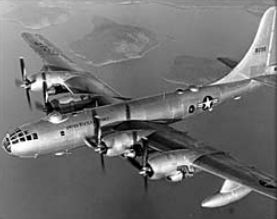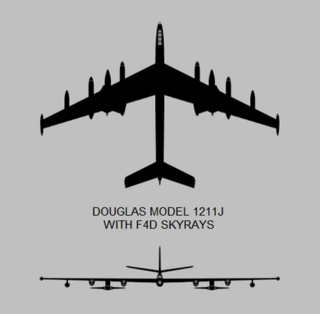
The Convair YB-60 was a prototype heavy bomber built by Convair for the United States Air Force in the early 1950s. It was a purely jet-powered development of Convair's earlier mixed-power B-36 Peacemaker.

The Convair R3Y Tradewind was an American 1950s turboprop-powered flying boat designed and built by Convair.

The Douglas XB-42 Mixmaster was an experimental American bomber aircraft, designed for a high top speed. The unconventional approach was to mount the two engines within the fuselage driving a pair of contra-rotating propellers mounted at the tail in a pusher configuration, leaving the wing and fuselage clean and free of drag-inducing protrusions.

The Northrop YB-35/XB-35, Northrop designation N-9 or NS-9, were experimental heavy bomber aircraft developed by the Northrop Corporation for the United States Army Air Forces during and shortly after World War II. The airplane used the radical and potentially very efficient flying wing design, in which the tail section and fuselage are eliminated and all payload is carried in a thick wing. Only prototypes and pre-production aircraft were built, although interest remained strong enough to warrant further development of the design as a jet bomber, under the designation YB-49.

The Boeing B-50 Superfortress is an American strategic bomber. A post–World War II revision of the Boeing B-29 Superfortress, it was fitted with more powerful Pratt & Whitney R-4360 radial engines, stronger structure, a taller tail fin, and other improvements. It was the last piston-engined bomber built by Boeing for the United States Air Force, and was further refined into Boeing's final such design, the prototype B-54. Although not as well known as its direct predecessor, the B-50 was in USAF service for nearly 20 years.

The Boeing XB-15 was a United States bomber aircraft designed in 1934 as a test for the United States Army Air Corps (USAAC) to see if it would be possible to build a heavy bomber with a 5,000 mi (8,000 km) range. For a year beginning in mid-1935 it was designated the XBLR-1. When it first flew in 1937, it was the most massive and voluminous airplane ever built in the US. It set a number of load-to-altitude records for land-based aircraft, including carrying a 31,205 lb (14,154 kg) payload to 8,200 ft (2,500 m) on 30 July 1939.
The Martin XB-16, company designation Model 145, was a projected heavy bomber designed in the United States during the 1930s.

The Douglas XB-19 was a four-engined, piston-driven heavy bomber produced by the Douglas Aircraft Company for the United States Army Air Forces (USAAF) during the early 1940s. The design was originally given the designation XBLR-2. It was the largest bomber built for the USAAF until 1946, with the Convair B-36 surpassing it in size.
The Boeing Y1B-20 was designed as an improvement on the Boeing XB-15. It was slightly larger than its predecessor, and was intended to use much more powerful engines. It was presented to the Army in early 1938, and two orders were placed soon after. The order was reversed before construction began.

The XB-38 Flying Fortress was a single example conversion of a production B-17E Flying Fortress, testing whether the Allison V-1710 V type engine could be substituted for the standard Wright R-1820 radial engine during early World War II.

The Convair XB-46 was a single example of an experimental medium jet bomber which was developed in the mid-1940s but which never saw production or active duty. It competed with similar designs, the North American XB-45 and Martin XB-48, all of which saw little use after the successful development of the Boeing XB-47.

The North American Aviation XA2J "Super Savage" was a prototype carrier-based attack aircraft built in the early 1950s. It was developed by North American Aviation (NAA) from the smaller AJ Savage.

The Martin XB-48 was an American medium jet bomber developed in the mid-1940s. It competed with the Boeing B-47 Stratojet, which proved to be a superior design, and was largely considered as a backup plan in case the B-47 ran into development problems. It never saw production or active duty, and only two prototypes, serial numbers 45-59585 and 45-59586, were built.

The Boeing YB-9 was the first all-metal monoplane bomber aircraft designed for the United States Army Air Corps. The YB-9 was a much enlarged twin-engine development of Boeing's single-engine Model 200 Monomail commercial transport.
The Boeing XB-56 was a proposal by Boeing for a re-engined version of the American jet-powered medium bomber aircraft, the B-47 Stratojet. The original designation for this modification was YB-47C.

The Boeing XB-59, was a 1950s proposal for an American supersonic bomber aircraft.

The Allison T40, company designation Allison Model 500, was an early American turboprop engine composed of two Allison T38 power sections driving a contra-rotating propeller via a common gearbox.
The Douglas DC-8 was an American piston-engined airliner project by Douglas Aircraft. A concept developed more than a decade before the DC-8 jetliner, the piston-engined DC-8 was to have propellers in the tail, an idea first used at Douglas by Edward F. Burton on a fighter project. The airliner project was canceled after development costs made it commercially unviable.

The Douglas 1211-J was a bomber aircraft design developed by American aircraft manufacturer Douglas to compete with the Boeing B-52 design for a major United States Air Force contract between 1946 and 1954. The Model 1211-J design was 160 feet long with a wingspan of 227 feet, and was powered by four turboprop engines. The aircraft was designed around a new 43,000-pound conventional bomb but could carry nuclear weapons as well. It could also carry its own fighter escorts, as parasites under its wings. These fighters' jet engines were to be powered up to assist the carrier bomber during takeoff; refueling of the fighters was to take place while they were stowed on the mothership's underwing pylons.
The Boeing XP3B-1 was a proposed patrol aircraft, developed by Boeing for use by the United States Navy in the late 1940s. It was planned to be powered by two Allison T40 turboprops driving contra-rotating propellers, and utilized tandem landing gear. The project was cancelled before any aircraft were built.















